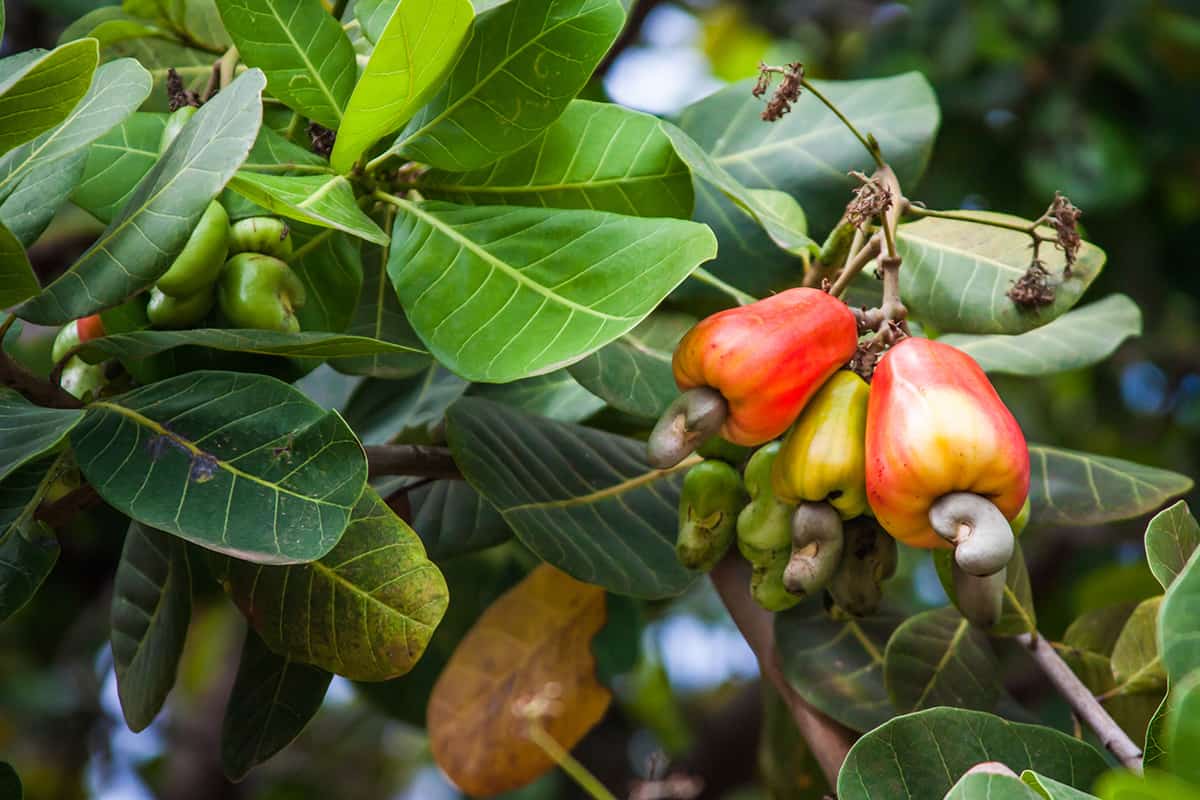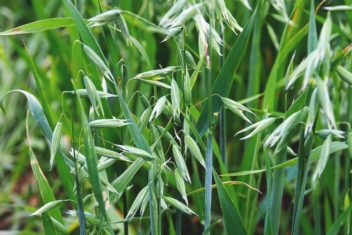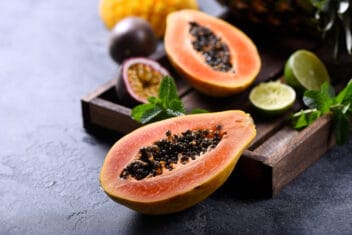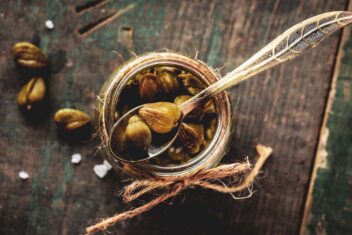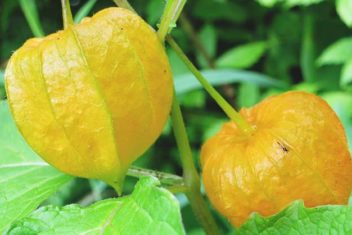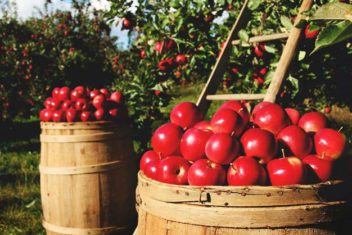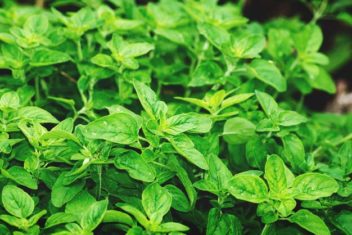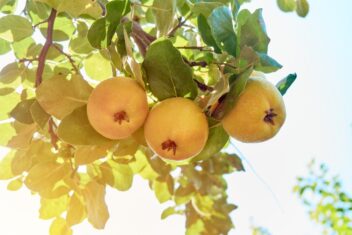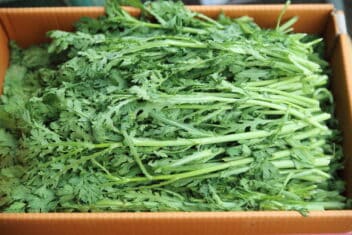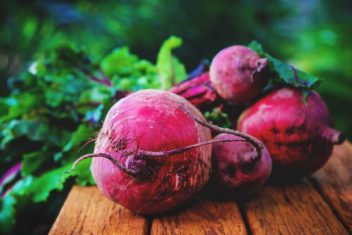Do you love munching on cashews in the cans of mixed nuts? Growing cashew trees at home is totally possible if you live in a subtropical or tropical region, so you can have your own ready supply.
Most people don’t think about growing nut trees at home like they grow fruit trees, but it’s not as hard as you might think. You need the right environment and to know the right tricks to growing cashews.
Can’t wait to dig in? Let’s get started.
Get to Know Cashew Trees
Cashew trees (Anacardium occidentale) originate from the Caribbean Islands and Brazil, but nowadays, they’re grown throughout the world’s tropical regions. They’re most often found in Africa, India, and Southeast Asia.
Cashew trees grow up to 40 feet tall with evergreen, oval, leathery leaves. The trees have beautiful pink blossoms, so they’re ornamental on top of providing food.

Speaking of food… when looking for the nuts on the tree, it’s easy to be fooled because the tree produces cashew apples that are oval-shaped. Cashew apples look like a yellow, orange, or red bell pepper; they’re edible, so don’t worry. These aren’t really apples, but rather the swollen stem of the fruit.
The nuts are attached to the end of the “fruit.” That’s where you’ll find the nut everyone knows as cashews.
Growing cashew trees is perfect for beginners, so long as you live in a subtropical or tropical region. The key is to make sure to add compost to the hole where you plant the trees and take care to water and fertilize regularly.
Growing Cashew Trees
If you have the proper environment and growing conditions, growing cashew trees isn’t difficult. These trees grow in USDA zones 10-11, so they need to be in a subtropical or tropical region.
Unfortunately, those who live outside of those regions cannot grow cashews because these trees need to be planted in the ground and won’t live through cold temperatures. These trees need to grow in areas where the temperature doesn’t drop below 50°F; they prefer an average temperature around 80°F, but they handle all the way up to 105°F well.
Let’s look at the requirements needed to grow cashew nut trees.
When to Plant Cashews
You can grow cashew seeds at any time, but the best time to sow seeds is in the fall or the winter. Saplings can be grown under a cover until they’re ready to be planted in the spring.
Where to Plant Cashew Trees
Cashew trees need at least six hours of direct sunlight to grow. Make sure the area you select requires that each day throughout the year. If you plant these trees in an area with shade, the tree will grow slowly and never produce fruits.
Make sure the area has well-draining soil; never plant these trees in clay-rich soil because the roots will become waterlogged, which will kill the trees over time.
Keep in mind when selecting a location that these trees reach up to 40 feet tall and need a distance of 30 feet between each tree.
Preparing the Soil for Cashew Trees
Cashew trees grow best in sandy, laterite soil with a pH level between 5 and 6.5. Make sure you apply compost in the hole before planting the tree to provide the nutrients needed to grow. Compost also helps the soil to drain properly.
How to Grow Cashew Trees from Seeds
If you want to grow cashew trees from seeds, you need to find a matured, unshelled nut (or seed in this case). Also, keep in mind that trees grown by seed won’t grow true to type. Cashew seeds are viable for up to four months. Once collected, you need to dry it in the sun for three days and soak it in water overnight.
It’s best to sow fresh cashew seeds because they germinate easier and faster. Sow the seed in a seed starting mix and wait for it to germinate. Cashew seeds take up to three weeks to germinate.
Keep the seeds in a warm area with some indirect light, but make sure the container isn’t in full sunlight. Check the soil regularly to ensure it’s not drying out.
Growing Cashew Trees From Potted Plants
If you don’t feel comfortable starting your nut tree from seeds, the next best option is to find a grafted tree or seedling at a local garden nursery. This option is preferred for new gardeners who have never propagated from trees before.
Planting Cashew Trees
No matter if you’re growing cashew trees from seeds or a potted grafted tree, you need to dig a hole that is twice as large as the root ball. Put compost at the bottom of the hole and spread out the roots of the cashew tree, gently placing the tree in the hole.
Fill the hole with the rest of the soil, pressing down firmly. Water the ground deeply to help the roots establish, and spread mulch around the base of the tree.
Caring for Cashew Trees
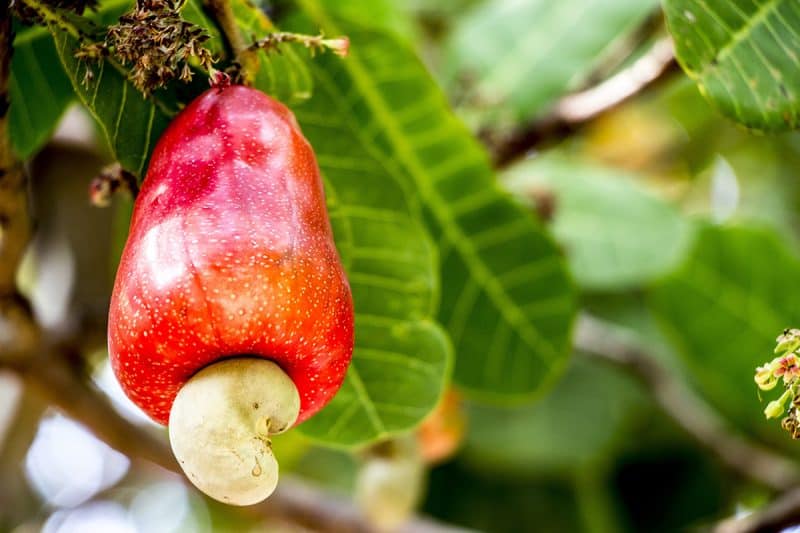
Once your trees are planted, caring for your young tree takes time. As the tree gets older, it requires less frequent care and watering, but in the early years, you need to remember to water and fertilize regularly.
Watering Your Cashew Tree
Once established, cashew trees are moderately drought tolerant, but the more water they receive, the more fruits and nuts the tree produces. It’s best to water your trees throughout the summer each week; once or twice is sufficient, and make sure to water deeply.
When the winter arrives reduces or withhold watering. The last thing you want to do is overwater your trees because it can kill them. Water deeply and let the soil dry out between watering.
Fertilizing Cashew Trees
Cashew trees benefit from regular fertilizer applications; it leads to a higher yield of fruits.
Use a slow-release fertilizer, and follow the instructions on the back of the package. Apply the fertilizer around the base of the tree every two months throughout the growing season. You also need to apply compost each year to the surface of the soil around your tree.
Pruning The Cashew Tree
Pruning is an essential step when you grow any fruit or nut tree. Regular pruning needs to be done to remove weak, dead, and entangled branches. Remove branches infested with pests or diseases.
You should also prune off overcrowded branches to promote better growth. Look for branches that cross; when branches cross, they rub, increasing the risk of damaging one of the branches. A damaged branch increases the risk of diseases.
Don’t Forget to Mulch
Each year, you should apply a new layer of mulch around the base of your tree. Mulch helps to prevent the growth of weeds and preserves moisture in the soil. You’ll need to apply more mulch each year because it washes away or decomposes into the soil.
Common Pests and Diseases
In general, cashew trees deal with little to no pest or disease problems. That makes it an easy nut tree to grow for beginners. Though rare, there are a few pests that you might deal with when growing these trees.
Cashew Weevil
The adult cashew weevils are large and gray-brown with a knobby appearance, while the larvae are legless grubs that are white. They lead to a gummy, insect excrement on the trunk of the trees, leading to the death of the tree.
Remove the bark from the infested area on your trees and destroy any larvae or pupae that might be found on or around the tree. It takes several months to remove all of these. Unfortunately, severely infested trees need to be removed and destroyed.
Coconut Bug
Another pest that might infest your cashew tree is the coconut bug. The adults are red-brown in color, while the nymphs vary from red to green. They lead to necrotic lesions on the fruits that eventually develop into hard lumps and spotting on the kernels.
The best method of control is to conserve the natural enemies of the coconut bug in your garden, which will help control pest populations naturally. Weaver ants and fire ants are two of the best natural enemies of coconut bugs. You can use insecticides if the infestation is too bad.
Helopeltis Bugs
Never heard of helopeltis bugs? You aren’t alone. Also known as mosquito bugs, these pests have thin bodies with long legs and antennae. Seriously; the antennae are twice as long as the body. The females are red while the males are brown. They kind of resemble a big mosquito.
Helopeltis bugs lead to deformed leaves with angular lesions on the veins, and the fruits might drop off of the plant. They can lead to some serious damage, so you should watch for signs of these pests regularly.
To combat thaem, introduce natural enemies to take care of the populations, such as weaver and green tree ants. You can also use chemical pesticides if the infestation gets bad.
Harvesting Cashews
When the cashew apples on the trees start to turn pink or red, look to see if the cashew nut shells are gray. That’s when it’s time to harvest the nuts. If you grow the tree from seeds, expect it to take three to five years to produce the first fruits.
Believe it or not, those cashew apples are edible, so don’t toss them away. You can eat them raw or make a cashew apple juice with them.
Leave the cashews in the shell for up two years; they’ll be fine if kept in a cool, dark location.
When it’s time to process the cashews, don’t break the shells before roasting because cashew shells contain caustic oil that will burn your skin. Wear gloves and take care when processing them.
Processing Cashews
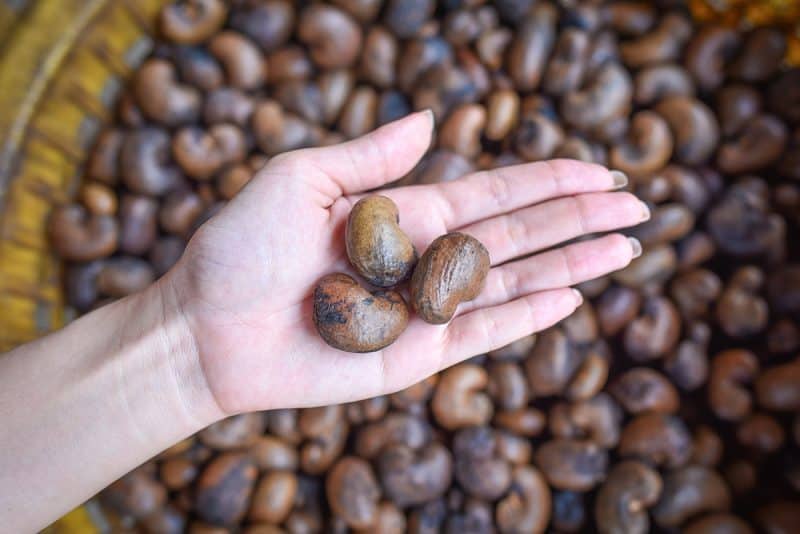
Unlike other nuts, you can’t pop open shells and eat the nuts inside. The shell is full of a nasty liquid that will literally burn holes into your skin. You have to separate the nuts from the shells without burning your skin or getting it into your eyes.
That’s why safety goggles and gloves are a MUST when processing cashews. Once you have your protective clothing, you have a few options when processing homegrown cashews.
1. Freeze the Shells
One of the easiest methods of processing cashews is to freeze the shells and separate the shell from the nut before it thaws out. You still need to wear gloves and safety glasses just to be safe. After the shells and nuts are separated, you can eat the nuts raw, but make sure to clean off any liquid before eating.
2. Roast the Cashews
The second method is to roast the cashews. You need a mask, long gloves, and sleeves that cover your arm before you get started.
Heat up vegetable oil to 410°F and put the nuts into the oil for two minutes. Don’t let them cook for longer than two minutes or they’ll become brittle.
After that, drop them into a bucket of water and take the nuts of the shell. Allow them to dry on a towel and then dig in.
